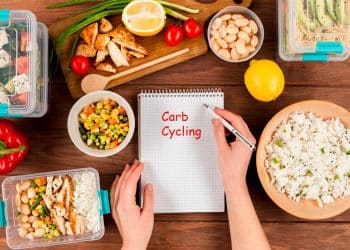Summer is quickly coming to an end (at least in most places), which means beach days, and walking around with minimal clothing to show off that lean physique will be much less, or no more, for the next several months.
Many will use this period to throw all discipline out the window, liberally packing on the fat pounds because they’ll be hiding behind thick clothing and fur coats for a while anyway. Then, they’ll hustle to shed all of the weight they packed on. Well, to be quite honest, this strategy is becoming more and more obsolete, especially when done in an excessive manner.
Not to mention, these big weight fluctuations are unhealthy, and a real pain when it comes time to start shedding the fat again. Ultimately, the choice is yours but at least hear us out on the calorie cycling method that can help you achieve new levels of fat loss progress while keeping your health in check.
This method is ideal for those with average, to lower body fat levels (e.g. 15% and under for men and 24% and under for women). The reason being is because those overweight or obese simply need to reduce their overall calories, and there’s no need to be overwhelmed with more advanced diet methods.
Now let’s get started…
What is Calorie Cycling?
We all know that being in an energy deficit or consuming fewer calories than what our bodies need to maintain a certain body weight, is how weight/fat loss occurs. This is common-knowledge. However, the more you’ve lost, the harder and harder it gets to continue at the same pace. This typically requires a bit more strategy to not only lose that additional fat but to also preserve as much muscle tissue as possible.
Level Up Your Fitness: Join our 💪 strong community in Fitness Volt Newsletter. Get daily inspiration, expert-backed workouts, nutrition tips, the latest in strength sports, and the support you need to reach your goals. Subscribe for free!
But calorie cycling can actually work for anyone looking to lose weight and keep it off too.

Calorie cycling, also called calorie shifting, is when you include a few higher-calorie days to balance out the potentially undesirable long-term nature of chronic low-calorie dieting. You’ll typically alternate between several lower-calorie and a few higher-calorie days during the week or monthly. Carbs and fats are usually the macronutrients manipulated to achieve the caloric difference.
Calorie cycling is not necessarily a diet, but it’s recommended to keep track of calories to ensure a precise outcome. This shouldn’t be an inconvenience for most, as it doesn’t require a whole lot of effort but to write down or enter numbers into an app or calculator. There are also no specific food restrictions, and you can modify based on what you find works most effectively for you.
Now let’s jump into the benefits of calorie cycling.
Benefits of Calorie Cycling
There are a few advantages to calorie cycling besides improved weight loss.
Prevents mental burnout
One is that it gives the dieter a sort of mental halftime break. Following a calorie-restricted diet isn’t easy, especially when we, as a society, have become so accustomed to eating without much limitation. Of course, those who are used to long-term dieting may not have much issue with this.

But that’s why calorie cycling is just one of the many strategies or options available. It’s not a must or necessary for everyone.
Another mental benefit is that some days, you may feel the need to indulge a little of which this eating strategy allows for. We don’t recommend pigging out, but you get the drift.
Anyway, following a calorie cycling plan should help you to stay on track.
Fueling up for physical activities
Another benefit of calorie cycling is that it’s a great method for ensuring you have sufficient carbs to fuel your more active days while minimizing excess caloric intake on less active days.
For example, if you’re sitting at a desk all day, then go home and lounge around before bedtime, eating more calories on that day is not necessary. But if you’re training hard at the gym, playing sports, etc, you’ll need the energy. That’s where calorie or carb cycling is beneficial.
Weight loss
Calorie shifting has shown in studies to have favorable results for weight loss and certain factors of health.
For example, one study compared the effects of calorie-restricted diets vs. calorie shifting diets. The study involved 74 overweight and obese participants who followed either diet or a control diet. At the end of the study, it was determined that the calorie shifting diet “was associated with a greater improvement in some anthropometric measures” (1).

Anthropometric measurements are defined by “a series of quantitative measurements of the muscle, bone, and adipose tissue used to assess the composition of the body.”
According to scientific literature, the primary elements of anthropometry include, “height, weight, body mass index (BMI), body circumferences (waist, hip, and limbs), and skinfold thickness.”
These elements are key factors for diagnosing obesity and subsequently, being able to take preventative measures or introducing interventions against chronic disease (e.g. diabetes, heart disease, etc).
In the same study, researchers also found that hunger decreased and satisfaction increased in the calorie shifting diet group after four weeks.
Drawbacks to conventional calorie-restricted diets
Many studies have determined that conventional calorie-restricted dieting tends to be harder to stick with, not to mention, a large percentage of dieters regain the weight.
Psychological factors
One study found that psychological factors may play a significant role in the inability to maintain body weight after successful weight loss (e.g. emotional eating, mental factors, etc) (2).
This was determined when only 28 out of 76 formerly obese women were able to maintain their weight loss after one year.
Not to mention, one review of studies discovered that the majority of people regained roughly 60% of the weight they had lost within a year. (3).
Therefore, it’s evident that long-term conventional calorie-restricted diets are not ideal for a large percentage of dieters. Also, metabolic adaptations have shown to play a role in the issue of maintaining weight after weight loss. (4, 5, 6, 7, 8).
Metabolic factors
Metabolic adaptations result in the conservation of the body’s energy, thereby making weight maintenance difficult. An example of this is “survival or starvation mode,” which occurs when caloric intake is so low that the body responds by holding into fat, slowing the metabolism, using protein for energy, etc (not good over long periods).

The hormones leptin and ghrelin are key metabolic factors when it comes to weight management.
Leptin is a weight-regulating hormone that’s released from the adipose tissue of fat cells. It helps you to feel full and manages energy balance so that the body knows when it needs energy and when it doesn’t. Because leptin is made from fat cells, fat loss and fat gain will cause leptin levels to decrease or increase respectively.
The issue with this is that low leptin levels can result in increased appetite and serious food cravings, aka survival mode.
The mechanism by which leptin works in the body is similar to the function of insulin in those with diabetes. You see, typically, when leptin is released from fat cells, it causes the hypothalamus in the brain to regulate appetite, which subsequently allows the body to use those extra fat cells as energy (again, this is survival).
But people who carry excess body fat such as those who are obese, store up too much leptin in the blood which creates a resistance to the leptin. Therefore, the body’s ability to detect satiety is absent even if the leptin and energy levels are high. This is not good if the goal is to lose weight because you’ll eat and eat and eat, without leptin stepping in to say enough is enough!
One study found that introducing three carb refeed days increased leptin levels by 28% and 24-hour energy expenditure by 7% (9).
There are also other studies that have shown that introducing higher-calorie days in addition to conventional low-calorie dieting can offset suboptimal leptin levels.
Now let’s talk about ghrelin.
Ghrelin is a hormone that increases hunger levels. Consequently, it has the opposite effect of leptin. Studies have shown that weight loss increases ghrelin levels, which increases hunger (10, 11, 12).
In one study, when individuals consumed 29–45% more calories, they experienced an 18% decrease in ghrelin levels (13).
Other studies support this effect (14).
Level Up Your Fitness: Join our 💪 strong community in Fitness Volt Newsletter. Get daily inspiration, expert-backed workouts, nutrition tips, the latest in strength sports, and the support you need to reach your goals. Subscribe for free!
Other Effects of normal dieting on metabolic factors
Here are some of the other potentially undesirable effects of conventional, linear dieting that chronically restrict caloric intake.
Many different hormones are affected by chronic dieting such as the thyroid, testosterone, cortisol, and of course, dieting may decrease resting metabolic rate (adaptive thermogenesis), and it can also affect physical activity levels.
The thyroid is vital to healthy metabolism function and dieting has shown to cause a decrease in levels in the body (15).
Testosterone, which is the primary male sex hormone (also important for women) that is vital for muscle growth, fat loss, protein synthesis, etc, may also be affected by intense energy-restriction for prolonged periods (16).
You’ve probably heard of the potentially detrimental effects of high cortisol levels. Cortisol is a stress hormone that can wreak havoc on the body when produced in excessive amounts. Research shows that low-calorie dieting raises cortisol which may have negative consequences on mental well-being. Elevated levels are also responsible for increased fat gain and it can prevent the body’s ability to effectively build muscle (17, 18).
A good example of this is when a cancer patient has elevated levels of cortisol, and how it affects the body.
How To Do Calorie Cycling
Here’s some information that’ll hopefully help you to get started with calorie cycling. Remember, calorie cycling is not for everyone but if you need to mix things up and maybe have hit a fat/weight loss plateau, this is for you.
Also, there’s no single calorie cycling plan that will work for everyone just like there’s no one diet or workout regime that’s suitable for everyone either. Keep this in mind and don’t be afraid to experiment a little.
We recommended listening to your body and structuring a plan based on how you respond to a restricted-calorie diet.
Understanding the Process
For individuals with body fat percentages above 15% (men) or 24% (women), a balanced diet can be followed. This approach aims to help those striving for an extra level of leanness. Since everyone’s body is unique, self-experimentation is necessary to determine the most effective strategy. A good starting point includes:
- High Calorie Days: 12% above your maintenance intake
- Medium Calorie Days: Maintenance intake
- Low Calorie Days: 22% below your maintenance intake
Weight Loss Macro Composition
- Protein: 1.1-1.35g per pound of body weight
- Fat: 28% of daily calories
- Carbs: remaining daily calories
- Example: If I weigh 180 lbs and my maintenance is 2300 calories.
Medium Day:
- Protein: 198g (792 calories)
- Fat: 71g (639 calories)
- Carbs: 218g (872 calories)
Low Day: 1794 calories (2300 x .22 based on guidelines)
- Protein: 198g (792 calories)
- Fat: 56g (504 calories)
- Carbs: 124g (498 calories)
Muscle Gain Macro Composition
- Protein: 0.85-1.1g per pound of body weight
- Fat: 22% of daily calories
- Carbs: remaining daily calories
- Example: using the same scenario as before
High Day: 2576 calories (2300 x .12 based on guidelines)
- Protein: 198g (792 calories)
- Fat: 79g (711 calories)
- Carbs: 273g (1,073 calories)
Low Day: 1794 calories (2300 x .22 based on guidelines)
- Protein: 198g (792 calories)
- Fat: 56g (504 calories)
- Carbs: 166g (664 calories)
Determining Macros for Muscle Growth
Try consuming a caloric surplus (high calorie recommendations) for 4-5 days a week (preferably on workout days), and a caloric deficit (low calorie) OR maintenance (medium) on 2-3 days (rest days). If you find yourself losing weight or maintaining, then continue with maintenance on rest days. If you are gaining more than 1 lb per week, change the rest days to a deficit.
Macro Composition
- Protein: 0.85-1.05g per pound of body weight
- Fat: 22% of daily calories
- Carbs: remaining daily calories
- Example: using the same scenario as before
High Day: 2530 calories (2300 x .10 based on guidelines)
- Protein: 189g (756 calories)
- Fat: 77g (693 calories)
- Carbs: 270g (1,080 calories)
Low Day: 1840 calories (2300 x .20 based on guidelines)
- Protein: 189g (756 calories)
- Fat: 56g (504 calories)
- Carbs: 186g (744 calories)
Calorie cycling examples
There are many different ways to do calorie cycling. But we do recommend that on refeed days, you increase your calories to maintenance (the number of calories to maintain your body weight) or slightly above.
5-2 method
For example, you can do the typical 5 days low-calorie followed by 2 days of higher-calorie dieting where you increase your calories by 500-1,000 on the two days. This should ideally bring you up to maintenance calories or even slightly above.
This could be an ideal strategy for those who would like to eat a little more on the weekends.
Daily calorie cycling
You might even prefer to fluctuate your calories daily which would look something like 2,000 calories on day one, 1,600 the next, then 2,300 the following day and back down to 2,000 the very next day. This could allow you to take advantage of the fat-burning effects while not having to follow any form of extreme dieting for longer periods.
One month on, one week off
Or, you can diet strictly for 4 weeks and then introduce one higher-calorie refeed week. This may be ideal for those who are a little more disciplined and have the willpower to do low-calorie for prolonged periods. Then you can take a week to refeed which will also offset some of the potentially negative effects of prolonged low-calorie dieting.
There are just many different ways to structure a plan but most days should be low-calorie if the goal is weight loss (we’re assuming it is). Also, high-calorie days should ideally fall on the same day/s as your most intense training sessions.
But before you follow a calorie cycling routine, we recommend that you know your ideal macronutrient intake to ensure you consume the optimal ratio of protein, fats, and carbs based on your goal/s. This way, you can determine how many calories you need to reduce in the form of carbs or fats too. You’ll also get your recommended daily caloric intake for weight loss.
Use the macronutrient calculator here.
You can also use our carb cycling calculator (recommended), that’ll provide you with a weekly plan that is especially useful for active individuals. It’ll give you daily calorie and macronutrient numbers to aim for based on how quickly you want to lose fat/body weight.
Not to mention, carbs are better at raising levels of leptin compared to fat. So, we recommend mostly increasing the carbs on those refeed days.
Also, carbs are the body’s primary fuel source (unless you’re doing the keto thing). High-intensity exercise and activities require nutrients that can be broken down quickly enough to fuel physical activity, of which carbs are needed.
Make sure to exercise too!
Exercise should always be a part of your daily/weekly routine. Getting your heart rate up, and your body moving around whether you play sports, weight train, or just go for a brisk daily walk, is highly recommended for your health and to keep your metabolism functioning optimally.
You’ll factor in your daily activity levels when calculating ideal calorie and macronutrient intake. That way, you’ll ensure that you’re following a healthy nutrition plan that won’t leave you deficient, which is another drawback of constant chronic calorie restriction.
The ultimate goal is weight loss but you never want to compromise your health by neglecting proper nutrition and exercise.
Wrapping Up
Calorie cycling doesn’t seem like a bad idea, eh?
Many people looking to shed more pounds of fat are unfamiliar with this method but according to the research, it seems to have favorable effects on fat loss, while also keeping health in check. There’s no one-size-fits-all strategy for this method, but that’s OK because when it comes to individual outcomes, trial and error allow us to learn what works best for us.
References:
- Davoodi SH, Ajami M, Ayatollahi SA, Dowlatshahi K, Javedan G, Pazoki-Toroudi HR. Calorie shifting diet versus calorie restriction diet: a comparative clinical trial study. Int J Prev Med. 2014 Apr;5(4):447-56. PMID: 24829732; PMCID: PMC4018593.
- Byrne S, Cooper Z, Fairburn C. Weight maintenance and relapse in obesity: a qualitative study. Int J Obes Relat Metab Disord. 2003 Aug;27(8):955-62. doi: 10.1038/sj.ijo.0802305. PMID: 12861237.
- Dulloo AG, Montani JP. Pathways from dieting to weight regain, to obesity and to the metabolic syndrome: an overview. Obes Rev. 2015 Feb;16 Suppl 1:1-6. doi: 10.1111/obr.12250. PMID: 25614198.
- Dulloo AG, Montani JP. Pathways from dieting to weight regain, to obesity and to the metabolic syndrome: an overview. Obes Rev. 2015 Feb;16 Suppl 1:1-6. doi: 10.1111/obr.12250. PMID: 25614198.
- Fothergill E, Guo J, Howard L, Kerns JC, Knuth ND, Brychta R, Chen KY, Skarulis MC, Walter M, Walter PJ, Hall KD. Persistent metabolic adaptation 6 years after “The Biggest Loser” competition. Obesity (Silver Spring). 2016 Aug;24(8):1612-9. doi: 10.1002/oby.21538. Epub 2016 May 2. PMID: 27136388; PMCID: PMC4989512.
- MacLean PS, Higgins JA, Jackman MR, Johnson GC, Fleming-Elder BK, Wyatt HR, Melanson EL, Hill JO. Peripheral metabolic responses to prolonged weight reduction that promote rapid, efficient regain in obesity-prone rats. Am J Physiol Regul Integr Comp Physiol. 2006 Jun;290(6):R1577-88. doi: 10.1152/ajpregu.00810.2005. Epub 2006 Feb 2. PMID: 16455763.
- Tremblay A, Chaput JP. Adaptive reduction in thermogenesis and resistance to lose fat in obese men. Br J Nutr. 2009 Aug;102(4):488-92. doi: 10.1017/S0007114508207245. PMID: 19660148.
- Goele K, Bosy-Westphal A, Rumcker B, Lagerpusch M, Muller MJ. Influence of changes in body composition and adaptive thermogenesis on the difference between measured and predicted weight loss in obese women. Obes Facts. 2009;2(2):105-9. doi: 10.1159/000210369. Epub 2009 Apr 14. PMID: 20054213; PMCID: PMC6444599.
- Dirlewanger M, di Vetta V, Guenat E, Battilana P, Seematter G, Schneiter P, Jéquier E, Tappy L. Effects of short-term carbohydrate or fat overfeeding on energy expenditure and plasma leptin concentrations in healthy female subjects. Int J Obes Relat Metab Disord. 2000 Nov;24(11):1413-8. doi: 10.1038/sj.ijo.0801395. PMID: 11126336.
- Cummings DE, Weigle DS, Frayo RS, Breen PA, Ma MK, Dellinger EP, Purnell JQ. Plasma ghrelin levels after diet-induced weight loss or gastric bypass surgery. N Engl J Med. 2002 May 23;346(21):1623-30. doi: 10.1056/NEJMoa012908. PMID: 12023994.
- Rossow LM, Fukuda DH, Fahs CA, Loenneke JP, Stout JR. Natural bodybuilding competition preparation and recovery: a 12-month case study. Int J Sports Physiol Perform. 2013 Sep;8(5):582-92. doi: 10.1123/ijspp.8.5.582. Epub 2013 Feb 14. PMID: 23412685.
- Leidy HJ, Dougherty KA, Frye BR, Duke KM, Williams NI. Twenty-four-hour ghrelin is elevated after calorie restriction and exercise training in non-obese women. Obesity (Silver Spring). 2007 Feb;15(2):446-55. doi: 10.1038/oby.2007.542. PMID: 17299118.
- Robertson MD, Henderson RA, Vist GE, Rumsey RD. Plasma ghrelin response following a period of acute overfeeding in normal weight men. Int J Obes Relat Metab Disord. 2004 Jun;28(6):727-33. doi: 10.1038/sj.ijo.0802637. PMID: 15079159.
- Ravussin E, Tschöp M, Morales S, Bouchard C, Heiman ML. Plasma ghrelin concentration and energy balance: overfeeding and negative energy balance studies in twins. J Clin Endocrinol Metab. 2001 Sep;86(9):4547-51. doi: 10.1210/jcem.86.9.8003. Erratum in: J Clin Endocrinol Metab 2001 Dec;86(12):5972. PMID: 11549706.
- Kozłowska L, Rosołowska-Huszcz D. Leptin, thyrotropin, and thyroid hormones in obese/overweight women before and after two levels of energy deficit. Endocrine. 2004 Jul;24(2):147-53. doi: 10.1385/ENDO:24:2:147. PMID: 15347841.
- Rossow LM, Fukuda DH, Fahs CA, Loenneke JP, Stout JR. Natural bodybuilding competition preparation and recovery: a 12-month case study. Int J Sports Physiol Perform. 2013 Sep;8(5):582-92. doi: 10.1123/ijspp.8.5.582. Epub 2013 Feb 14. PMID: 23412685.
- Tomiyama AJ, Mann T, Vinas D, Hunger JM, Dejager J, Taylor SE. Low calorie dieting increases cortisol. Psychosom Med. 2010 May;72(4):357-64. doi: 10.1097/PSY.0b013e3181d9523c. Epub 2010 Apr 5. PMID: 20368473; PMCID: PMC2895000.
- Björntorp P, Rosmond R. Obesity and cortisol. Nutrition. 2000 Oct;16(10):924-36. doi: 10.1016/s0899-9007(00)00422-6. PMID: 11054598.












